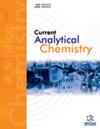New Green and High-throughput Microwell Spectrophotometric Method for Quality Control of Pharmaceutical Formulations of Selective Serotonin Reuptake Inhibitors via Microscale Formation of their N-Vinylaminonaphthoquinone Derivatives
IF 1.7
4区 化学
Q3 CHEMISTRY, ANALYTICAL
引用次数: 0
Abstract
Background: Selective serotonin reuptake inhibitors (SSRIs) are mostly prescribed for the treatment of depression. This study describes the microscale in-microwell formation of blue-colored N-vinylamino-naphthoquinone derivatives of SSRIs upon their reaction with 2,3-dichloro-1,4- naphthoquinone (DCNQ) and acetaldehyde. The reaction was subsequently utilized as a basis for the development of a new simple and sensitive microwell spectrophotometric method (MW-SPM) for the quality control of pharmaceutical formulations of four SSRIs. These SSRIs are fluoxetine (FLU), sertraline (SER), paroxetine (PAR), and reboxetine (REB). Methods: The MW-SPM procedure was performed in 96-microwell transparent plates, and the microplate reader was employed to measure the absorbances of the reaction products at their peak absorbance wavelength of 580 nm. The best conditions for the method were determined. Results: The relations showed good linearity (correlation coefficients were ≥0.9992) in the concentration range of 5 – 600 µg/mL. The limits of detection ranged from 5.20 to 15.58 µg/mL. The precision was deemed acceptable since all cases' relative standard deviation (RSD) values remained below 2.21%. Recovery experiments were conducted to confirm the accuracy of the method, yielding recovery values of at least 97.8%. The MW-SPM method was effectively utilized to analyze SSRIs in both their bulk and pharmaceutical dosage forms, exhibiting acceptable accuracy and precision. The recovery values ranged from 99.4% to 101.0% (with a margin of error of ± 0.5% to 1.6%). The results were comparable with those of the pre-validated reported methods. Four different metric tools evaluated the greenness of the proposed method, and the results proved that the method fulfills the requirements of green analytical approaches. Furthermore, the ability to handle numerous microvolume samples simultaneously in the described method provides it with a high-throughput characteristic. Conclusion: The proposed MW-SPM represents a valuable tool for an efficient analysis of SSRIs in pharmaceutical quality control units.新型绿色高通量微孔分光光度法:通过微量生成 N-乙烯萘胺萘醌衍生物控制选择性羟色胺再摄取抑制剂药物制剂的质量
背景:选择性血清素再摄取抑制剂(SSRIs)主要用于治疗抑郁症。本研究描述了 SSRIs 与 2,3-二氯-1,4-萘醌(DCNQ)和乙醛反应后在微孔中形成的蓝色 N-乙烯萘醌衍生物。随后,以该反应为基础,开发了一种简单灵敏的微孔分光光度法(MW-SPM),用于四种 SSRIs 药物制剂的质量控制。这些 SSRIs 包括氟西汀 (FLU)、舍曲林 (SER)、帕罗西汀 (PAR) 和瑞波西汀 (REB)。研究方法在 96 微孔透明板中进行 MW-SPM 程序,使用微孔板阅读器测量反应产物在 580 纳米吸光峰波长处的吸光度。确定了该方法的最佳条件。结果表明在 5 - 600 µg/mL 浓度范围内,线性关系良好(相关系数≥0.9992)。检测限为 5.20 至 15.58 微克/毫升。由于所有情况下的相对标准偏差 (RSD) 值都低于 2.21%,因此精密度可以接受。为确认方法的准确性,进行了回收实验,回收率至少为 97.8%。MW-SPM 方法被有效地用于分析散装和药物剂型中的 SSRIs,其准确度和精密度均可接受。回收率为 99.4% 至 101.0%(误差范围为 ± 0.5% 至 1.6%)。结果与已报告的预验证方法相当。四种不同的度量工具对拟议方法的绿色性进行了评估,结果证明该方法符合绿色分析方法的要求。此外,该方法能同时处理大量微量样品,因此具有高通量的特点。结论所提出的 MW-SPM 是药品质量控制部门高效分析 SSRIs 的重要工具。
本文章由计算机程序翻译,如有差异,请以英文原文为准。
求助全文
约1分钟内获得全文
求助全文
来源期刊

Current Analytical Chemistry
化学-分析化学
CiteScore
4.10
自引率
0.00%
发文量
90
审稿时长
9 months
期刊介绍:
Current Analytical Chemistry publishes full-length/mini reviews and original research articles on the most recent advances in analytical chemistry. All aspects of the field are represented, including analytical methodology, techniques, and instrumentation in both fundamental and applied research topics of interest to the broad readership of the journal. Current Analytical Chemistry strives to serve as an authoritative source of information in analytical chemistry and in related applications such as biochemical analysis, pharmaceutical research, quantitative biological imaging, novel sensors, and nanotechnology.
 求助内容:
求助内容: 应助结果提醒方式:
应助结果提醒方式:


